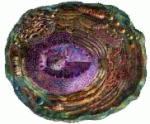Cell Biology
|
16 december 2014 01:45:51 |
| First co-expression of a lipase and its specific foldase obtained by metagenomics (Microbial Cell Factories) |
|
Tweet Background:
Metagenomics is a useful tool in the search for new lipases that might have characteristics that make them suitable for application in biocatalysis. This paper reports the cloning, co-expression, purification and characterization of a new lipase, denominated LipG9, and its specific foldase, LifG9, from a metagenomic library derived from a fat-contaminated soil.
Results:
Within the metagenomic library, the gene lipg9 was cloned jointly with the gene of the foldase, lifg9. LipG9 and LifG9 have 96% and 84% identity, respectively, with the corresponding proteins of Aeromonas veronii B565. LipG9 and LifG9 were co-expressed, both in N-truncated form, in Escherichia coli BL21(DE3), using the vectors pET28a(+) and pT7-7, respectively, and then purified by affinity chromatography using a Ni2+ column (HiTrap Chelating HP). The purified enzyme eluted from the column complexed with its foldase. The molecular masses of the N-truncated proteins were 32?kDa for LipG9, including the N-terminal His-tag with 6 residues, and 23?kDa for LifG9, which did not have a His-tag. The biochemical and kinetic characteristics of the purified lipase-foldase preparation were investigated. This preparation was active and stable over a wide range of pH values (6.5-9.5) and temperatures (10-40?C), with the highest specific activity, of 1500 U mg?1, being obtained at pH?7.5 at 30?C. It also had high specific activities against tributyrin, tricaprylin and triolein, with values of 1852, 1566 and 817 U mg?1, respectively. A phylogenetic analysis placed LipG9 in the lipase subfamily I.1. A comparison of the sequence of LipG9 with those of other bacterial lipases in the Protein Data Bank showed that LipG9 contains not only the classic catalytic triad (Ser103, Asp250, His272), with the catalytic Ser occurring within a conserved pentapeptide, Gly-His-Ser-His-Gly, but also a conserved disulfide bridge and a conserved calcium binding site. The homology-modeled structure presents a canonical ?/? hydrolase folding type I.
Conclusions:
This paper is the first to report the successful co-expression of a lipase and its associated foldase from a metagenomic library. The high activity and stability of Lip-LifG9 suggest that it has a good potential for use in biocatalysis. |
| 75 viewsCategory: Microbiology, Cell Biology |
 Development of bio-based fine chemical production through synthetic bioengineering (Microbial Cell Factories) Development of bio-based fine chemical production through synthetic bioengineering (Microbial Cell Factories)Engineering of Serine-Deamination pathway, Entner-Doudoroff pathway and pyruvate dehydrogenase complex to improve poly(3-hydroxybutyrate) production in Escherichia coli (Microbial Cell Factories) 
|
| blog comments powered by Disqus |
MyJournals.org
The latest issues of all your favorite science journals on one page
The latest issues of all your favorite science journals on one page



